Welcome to my connectivity guide. This article was originally published on 18/11/2016 but was updated on 12/04/2025 with new images and new ports.
This guide describes what I would call the main connections in my lifetime. I am old enough to remember the days of serial, parallel, and PS/2 ports before the days of USB.
The images used in this article have been redone using a combination of my work and AI.
Composite Video (RCA)
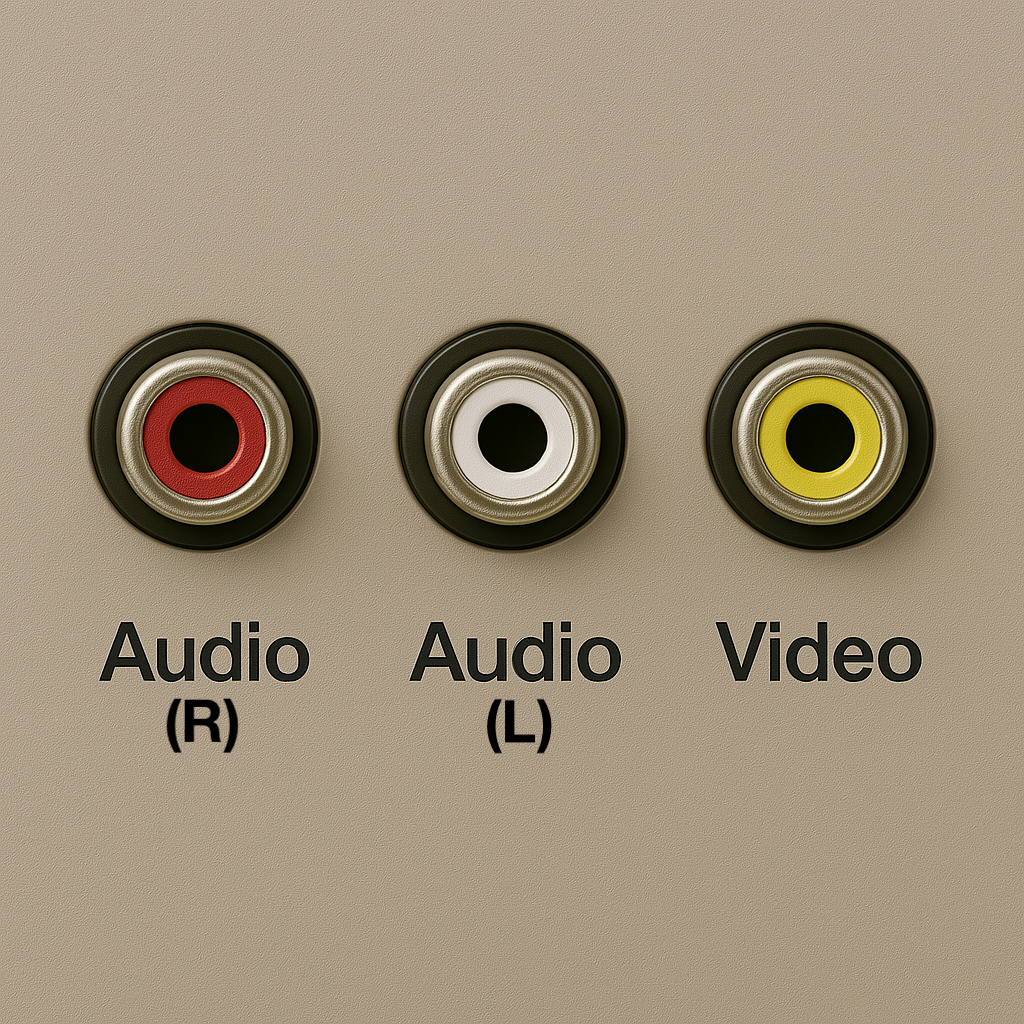
| Name | Composite Video (RCA) |
| Maximum speed?Speed Composite video is an analogue signal, so no digital speed is applicable. | N/A (analogue) |
| Colour | |
| Pin count | 1 (signal and ground) |
| Year | 1956 – early 2000s (mainstream use) |
Composite video is an analogue video signal that carries standard-definition video in a single channel. It combines brightness, colour, and synchronisation into one signal, which is transmitted over a single RCA connector—usually coloured yellow.
It was widely used on televisions, VCRs, games consoles, and DVD players. Though simple and inexpensive, composite video suffers from quality loss due to signal blending, particularly colour bleeding and reduced sharpness.
Composite video does not carry audio, so it's often used in conjunction with red and white RCA connectors for stereo sound. It has since been replaced by higher-quality analogue options like S-Video and component video and digital formats like HDMI, but still appears on legacy equipment and adapters.
3.5mm Audio Jack
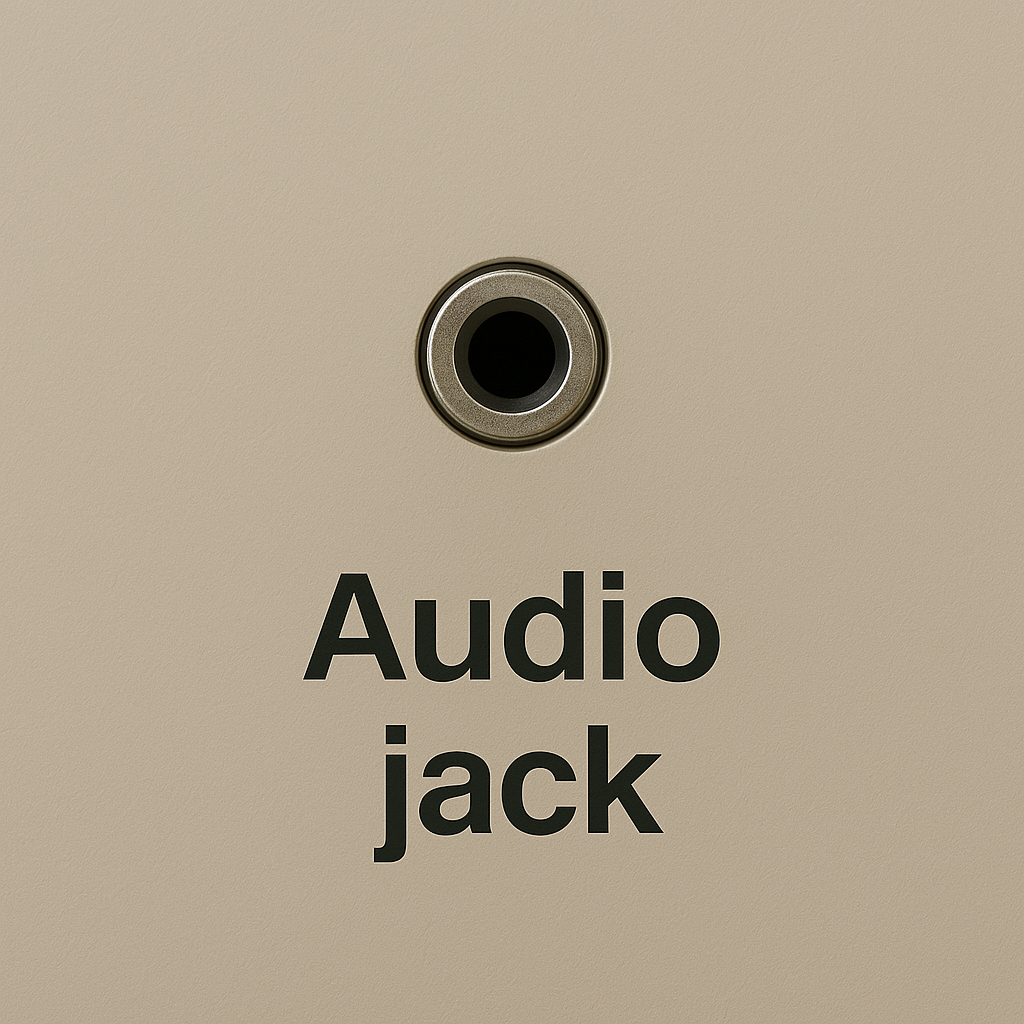
| Name | 3.5mm Audio Jack (TRS/TRRS) |
| Maximum speed?Speed This port is analogue and does not transmit digital data, so it has no digital speed rating. | N/A (analogue) |
| Colour | |
| Pin count | 3 (TRS) or 4 (TRRS) |
| Year | 1960s – present |
The 3.5mm audio jack, often referred to as a headphone jack, is a small, round connector primarily used for analogue audio signals. It has been used in a wide variety of devices, from portable music players and smartphones to computers and audio equipment.
The jack comes in several configurations: TRS (Tip-Ring-Sleeve) for stereo audio, and TRRS (Tip-Ring-Ring-Sleeve) which adds an extra connection for microphone input or video in some applications. Despite being analogue, the jack offers excellent sound quality and remains popular due to its simplicity and wide compatibility.
In many modern mobile devices, the 3.5mm port has been phased out in favour of digital audio over USB-C or Lightning connectors, though it remains a staple in professional audio, laptops, and desktop PCs.
Serial port (RS-232)
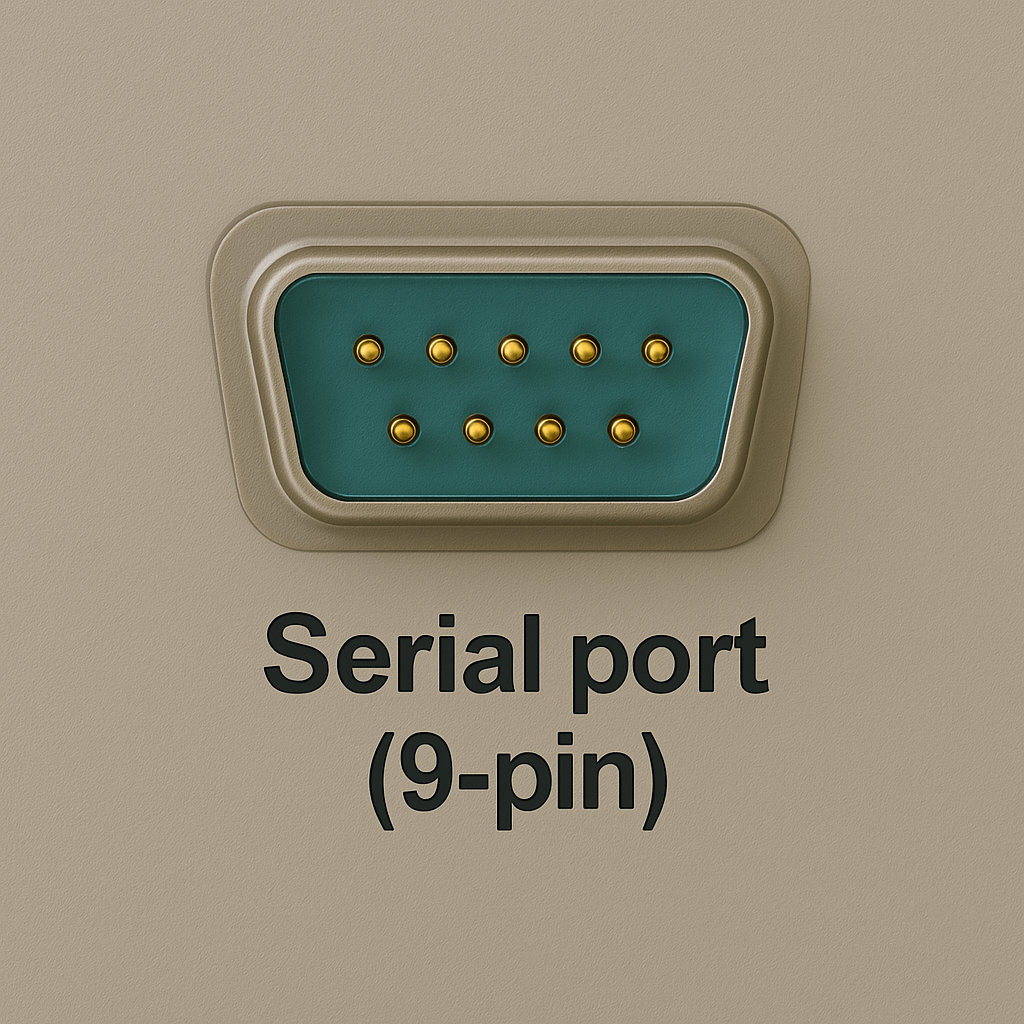
| Name | Serial port (RS-232) |
| Maximum speed?Speed The speed here is the theoretical speed, not actual speeds achieved regularly. | 120kbps |
| Colour?ColourThis is the colour as defined by PC 98 standard. It was not always enforced, but manufacturers generally followed it. | |
| Pin count | 9 |
| Year | 1970 - 2005 |
The serial port, officially the RS-232 connection as it complies with Recommended Standard 232, is now largely replaced by USB. This has been the case since 2002/2003, when notebook computers officially began ditching this connection in favour of the faster USB 1.1 and later USB 2.0 standards.
The serial port used a DE-9M (D-subminature) connector. These connectors provided screw lock posts to support them due to the large size of the connectors.
Serial ports were used in a variety of situations, including (perhaps their most important role) connecting modems to the system, connecting mice and keyboards to the system, controlling other devices (such as projectors, the only reason I still use RS-232), connecting to industrial equipment (such as point-of-sale equipment or computer numerically controlled hardware), and for diagnostic use.
RS-232 may not exist as a connection as such, but many devices still include the connector for propriety diagnostics due to the low cost of the port.
The serial port was named as such because it was the primary serial connection of a computer used for data. USB is the successor of the RS-232 port, and RS-232 disappeared from consumer computers around 2005.
Parallel port (IEEE1284)

| Name | Parallel port (IEEE1284) |
| Maximum speed?Speed The speed here is the theoretical speed, not actual speeds achieved regularly. | 150kbps - 16mbps (EPP) |
| Colour?ColourThis is the colour as defined by PC 98 standard. It was not always enforced, but manufacturers generally followed it. | |
| Pin count | 25 |
| Year | 1970 - 2008 |
The 'parallel port,' as it was generally known, was officially known as IEEE1284. It was used for various purposes.
The parallel port used a DB-25 (D-subminature) connector. These connectors provided screw lock posts to support them due to the large size of the connectors.
The parallel port was primarily used for connecting external drives and printers. It was also used, on occasion, with webcams, coupled with PS/2 for power.
While USB killed off the parallel port, notebook computers featured this port until around 2003 or 2004, and desktops did not stop including it until about 2008.
Perhaps it continued to be used for so long because so many hardware items (such as printers) used parallel ports that did not need to be replaced. It could also be down to its speed—the EPP parallel port was faster, in theory, than USB 1.1, making it a strong competitor. While USB was faster in almost all cases, the hardware (disk drives, etc.) was not fast enough to take advantage of the speeds for some time.
Game port (MIDI Port)
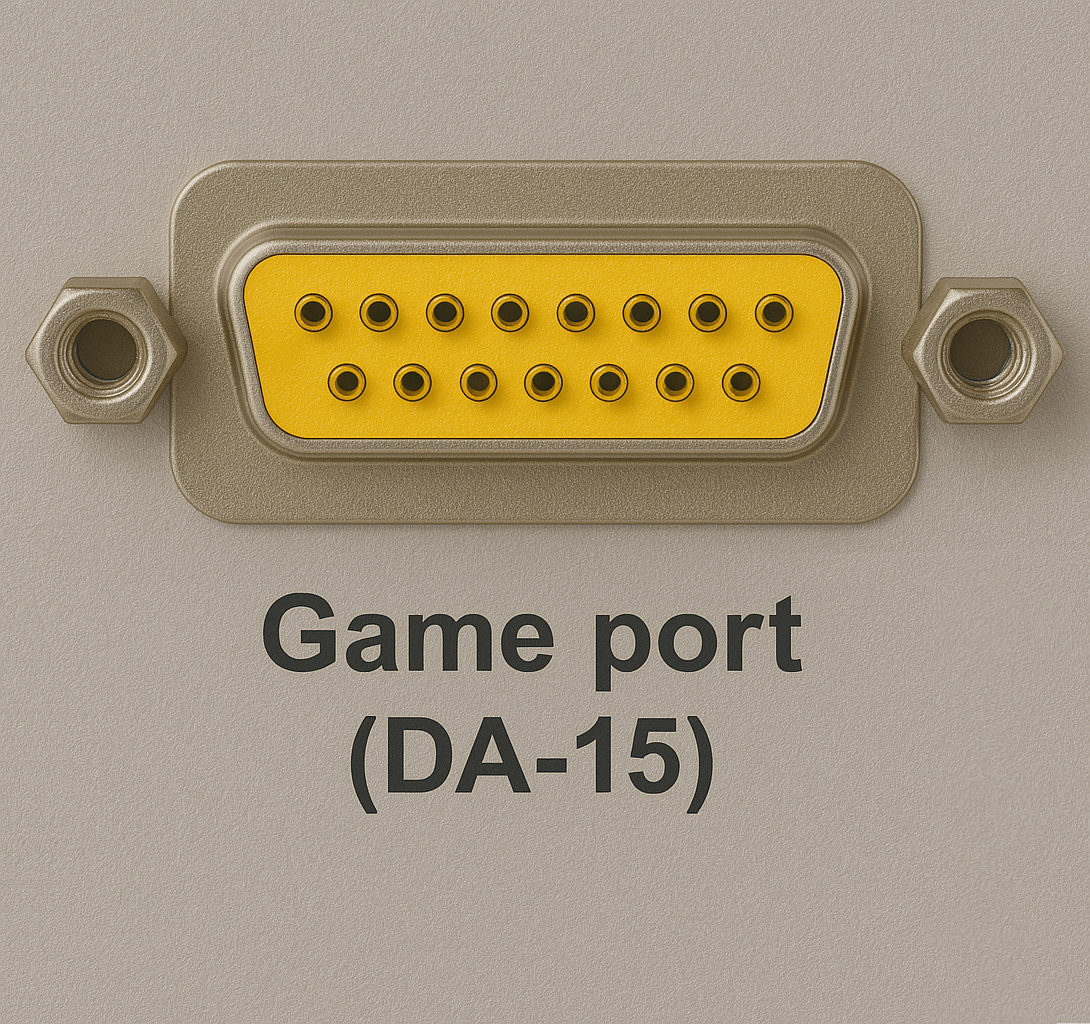
| Name | Game port (MIDI port) |
| Maximum speed?Speed The speed here is the theoretical speed, not actual speeds achieved regularly. | No speed due to being analogue |
| Colour?ColourThis is the colour as defined by PC 98 standard. It was not always enforced, but manufacturers generally followed it. | |
| Pin count | 15 |
| Year | 1981 - 1999 |
The game port or MIDI (musical instrumental digital interface) port is a semi-multipurpose connector that was particularly used for two purposes: connecting game devices like joysticks or gamepads to musical instruments such as digital keyboards.
The game port used a DA-15 (D-subminature) connector. These connectors provided screw lock post to support them due to the large size of the connectors.
These connectors were hugely popular with serious gamers until about 1999, when USB 1.1 took over from them. I personally used this connector with my joystick and Microsoft Simulator 1998 but eventually got myself a USB gamepad rather than a joystick.
As the USB port became increasingly popular and the declining game port became a thing of the past, many adapters became available to ensure that game port-based joysticks could be used with the newer USB connector.
Along with the serial, parallel, and PS/2 ports, the game port was purged by the USB port in the early 2000s.
Component Video (YPbPr)
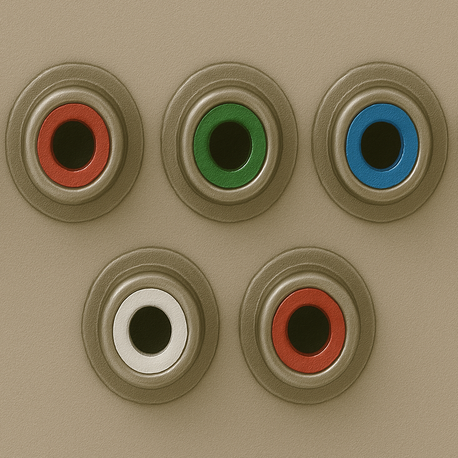
| Name | Component Video (YPbPr) |
| Maximum speed?Speed Component video is analogue, so no digital bandwidth is applicable. It supports resolutions up to 1080p depending on quality. | N/A (analogue) |
| Colour | |
| Pin count | 3 (video only) or 5 (with stereo audio) |
| Year | 1980s – 2010 (peak use) |
Component video, also known as YPbPr, is an analogue video format that separates the video signal into three distinct channels: Y (luminance), Pb (blue-difference), and Pr (red-difference). This separation offers significantly improved image quality over composite video.
Each channel is carried over an individual RCA connector, colour-coded as green (Y), blue (Pb), and red (Pr). These ports are often accompanied by white and red RCA connectors for stereo audio, making a total of five connectors on many devices.
Component video was commonly used on DVD players, TVs, and game consoles before the rise of digital video interfaces like HDMI. It supports resolutions up to 1080p and is still used on some legacy equipment and professional video gear.
PS/2
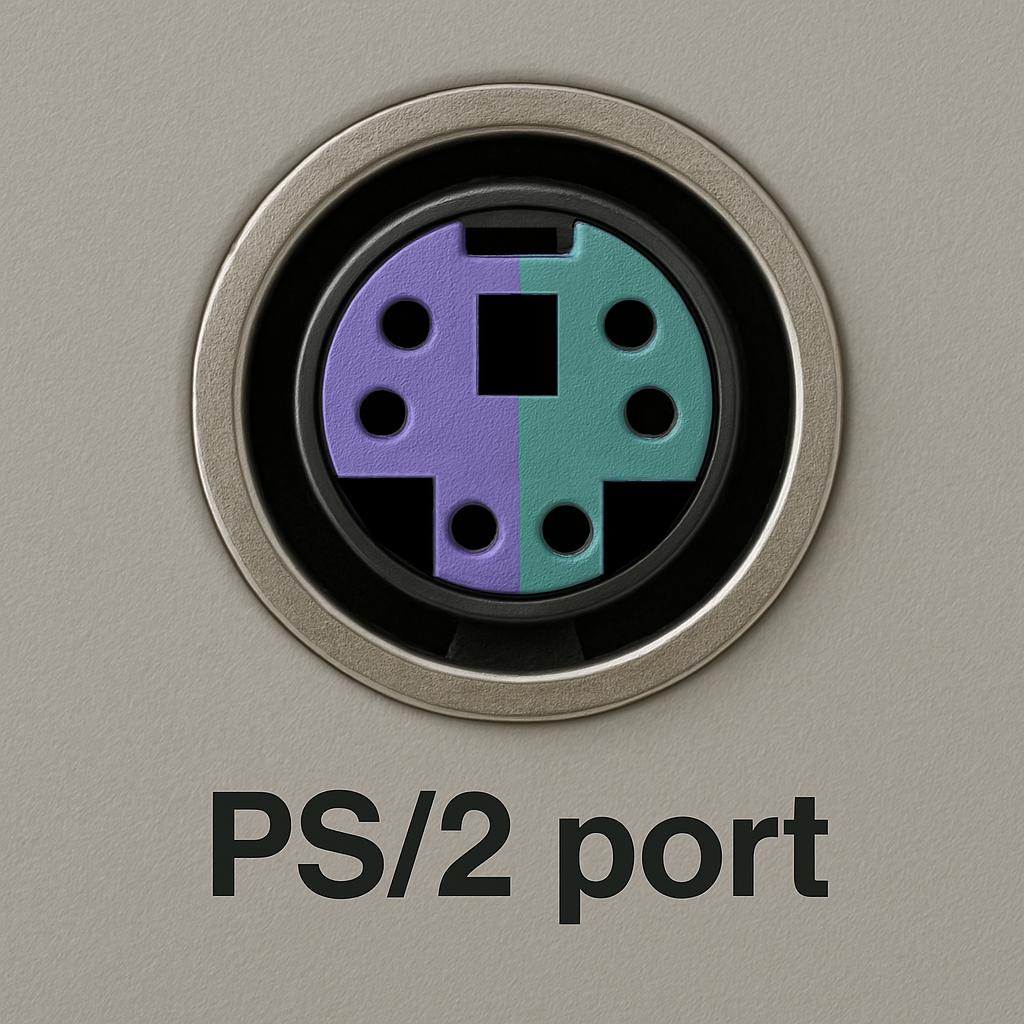
| Name | PS/2 port |
| Maximum speed?Speed The speed here is the theoretical speed, not actual speeds that are achieved regularly. | 10–16kbps |
| Colour?ColourThis is the colour as defined by PC 98 standard. It was not always enforced, but manufacturers generally followed it. | |
| Pin count | 6 |
| Year | 1987 - 1999 |
PS/2 or Personal System 2 was IBM's range of computers that featured some of the most revolutionary technologies including the 1.44MB floppy disk, the VGA standard and the PS/2 port.
PS/2, although considered a legacy connector, is still used today by many computers, especially in notebooks. The standard is much more energy efficient than USB due to the way that PS/2 works compared with USB. USB polls, which means it constantly goes back and forth between all devices on the hub (this is why I have never liked USB), whereas PS/2 sends a system interrupt. The difference here is that polling sends signals to the device, whereas interrupts have the device send the data to the system. The result is that polling drains battery life.
PS/2 was a physical external connector with three types: the mouse port (green), the keyboard port (purple), and the combination port, which was commonly found on notebook computers before the removal of the physical PS/2 port from notebooks.
The keyboard port was often used elsewhere as well. Webcams were sometimes piggybacked off the keyboard port for power whilst sending data using the parallel port.
PS/2 took the form of a 6-pin mini-DIN connector.
S-Video
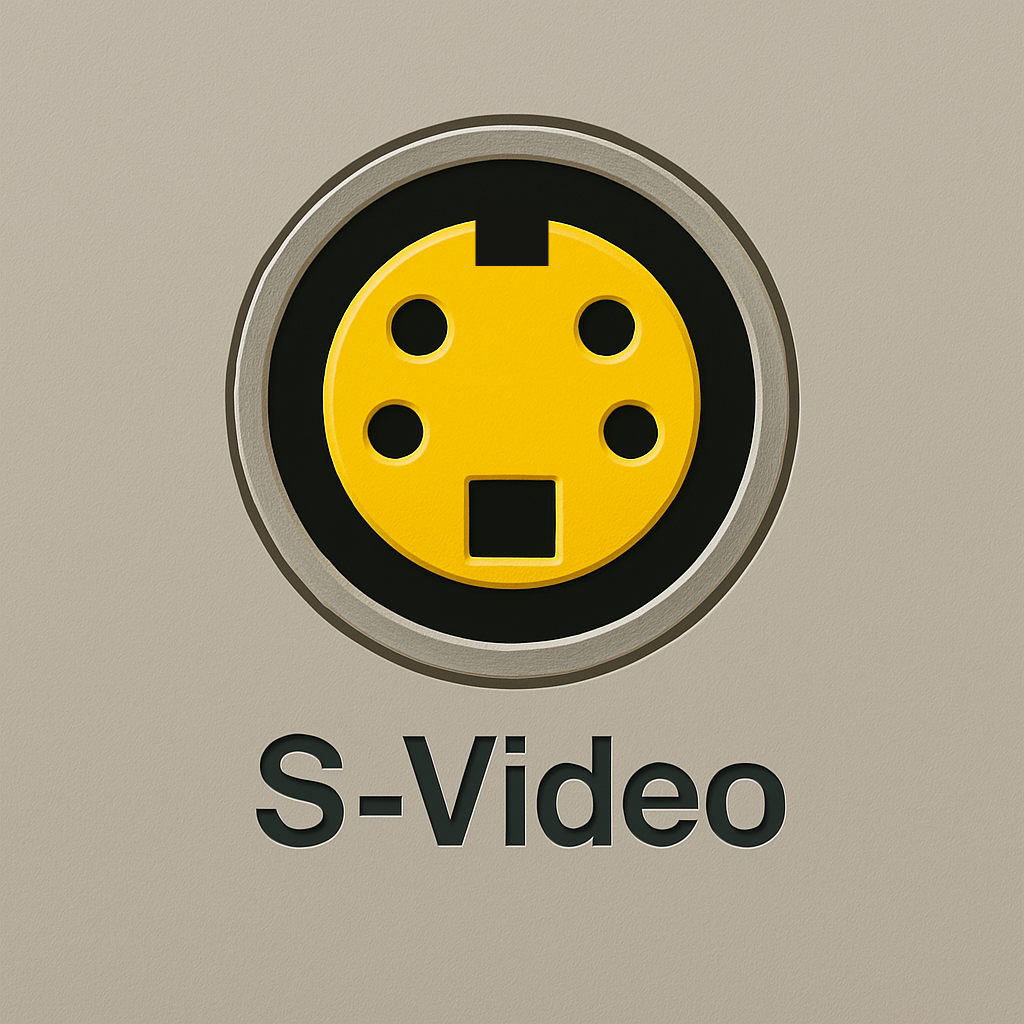
| Name | S-Video (Separate Video) |
| Maximum speed?Speed This is an analogue video interface and does not transmit digital data, so there is no speed rating. | N/A (analogue) |
| Colour | |
| Pin count | 4 (Mini-DIN) |
| Year | 1987 – early 2000s |
S-Video (short for Separate Video), also known as Y/C or Super Video, is an analogue video interface that separates brightness (luminance) and colour (chrominance) signals to produce a sharper image than composite video. It was commonly used on televisions, DVD players, game consoles, and video capture devices during the late 20th and early 21st centuries.
The S-Video connector is a 4-pin Mini-DIN, with a keying notch to ensure correct orientation. Though superior to composite in quality, it does not carry audio and has been largely replaced by modern digital connectors like HDMI and DisplayPort.
Despite being largely obsolete, S-Video is still found on some legacy equipment and remains relevant for enthusiasts and video conversion workflows.
VGA port
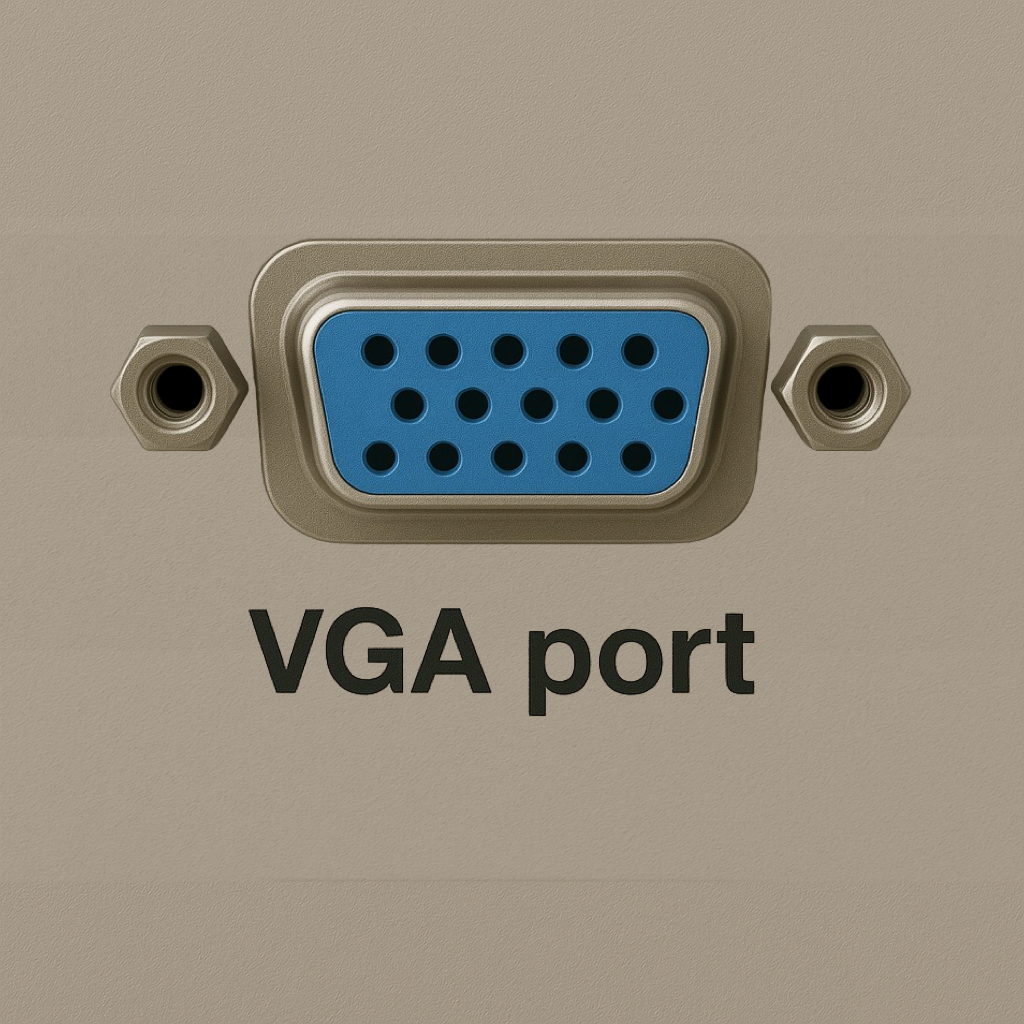
| Name | VGA port |
| Maximum resolution?Resolution Maximum supported resolution using analogue signals under ideal conditions. | 2048×1536 at 85Hz |
| Colour?ColourThis is the colour as defined by PC 98 standard. It was not always enforced, but manufacturers generally followed it. | |
| Pin count | 15 |
| Year | 1987 – present (legacy use) |
The VGA (Video Graphics Array) port, introduced in 1987 by IBM, is an analogue video connector that became the long-standing standard for computer monitors. It uses a DE-15 (often incorrectly referred to as DB-15) connector with 15-pin sockets arranged in three rows of five.
Typically coloured blue under the PC 99 system design guide, VGA ports are easily recognised by their trapezoidal shape and are usually female on the device side, accepting a male VGA cable. These ports transmit RGBHV analogue signals and support a variety of resolutions and refresh rates, though quality can degrade with longer cable lengths.
VGA has been largely replaced by digital standards such as DVI, HDMI, and DisplayPort, but due to its broad compatibility, it is still found on some projectors, monitors, and legacy equipment. Adapters are available to convert VGA to digital formats, but analogue-to-digital conversion can cause quality loss.
Despite its age, VGA remains in use in education, industry, and corporate environments where legacy systems are still common. However, support for VGA is increasingly being phased out on modern graphics cards and motherboards.
FireWire 400
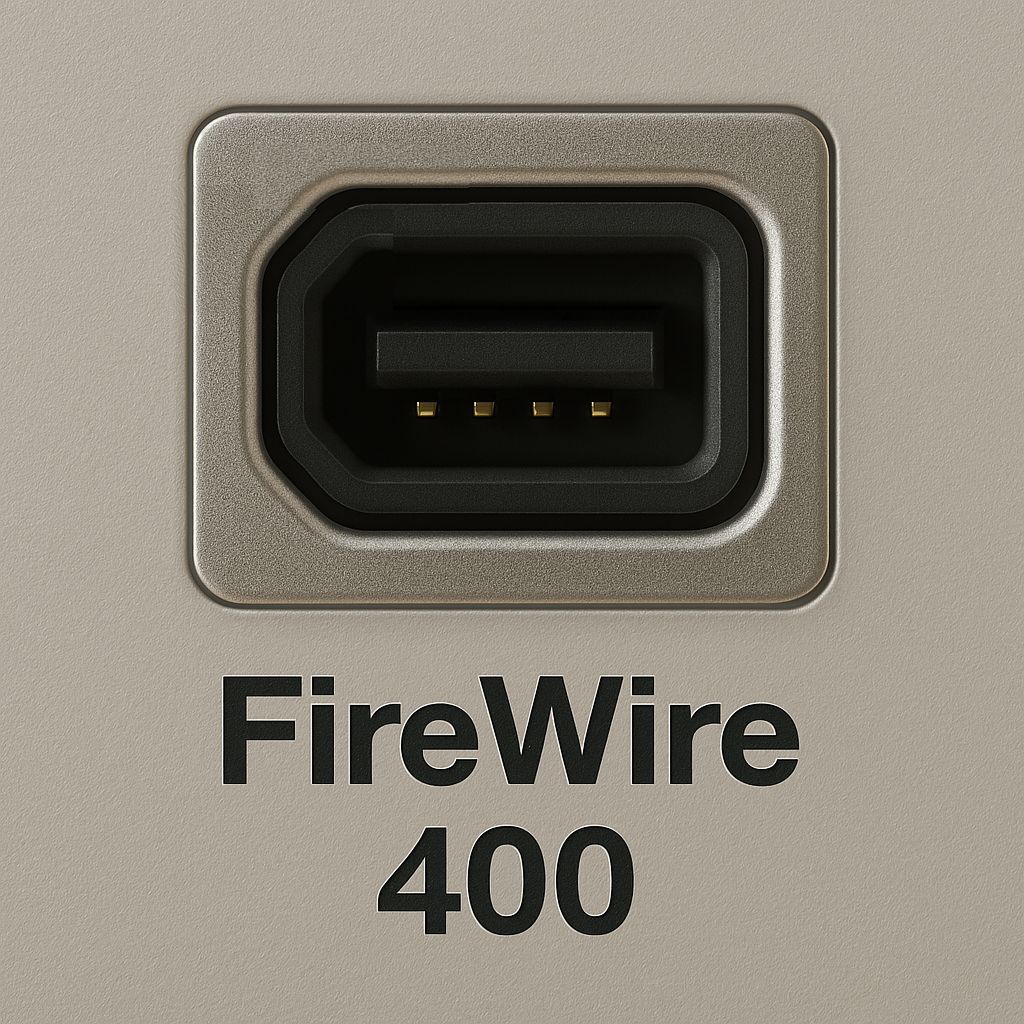
| Name | FireWire 400 (IEEE 1394a) |
| Maximum speed?Speed Maximum theoretical transfer rate supported by the port. | 400Mbps |
| Colour | |
| Pin count | 6 (or 4 on some compact devices) |
| Year | 1995 – 2010 (mainstream use) |
FireWire 400, also known as IEEE 1394a, was introduced in the mid-1990s as a high-speed data connection alternative to USB. It was most commonly used for digital video cameras, external hard drives, and professional audio equipment.
The 6-pin version supplies both data and power, while a smaller 4-pin version omits power and was commonly used in camcorders. The port is asymmetrical, with curved corners on the left-hand side and a flat right-hand edge, making it easy to distinguish visually.
FireWire 400 supported peer-to-peer connections, allowing devices to communicate without needing a computer as an intermediary — a unique feature for its time. While it was faster than USB 1.1 and had advantages for multimedia, USB 2.0's widespread adoption eventually eclipsed it.
USB 1.1 and 2.0
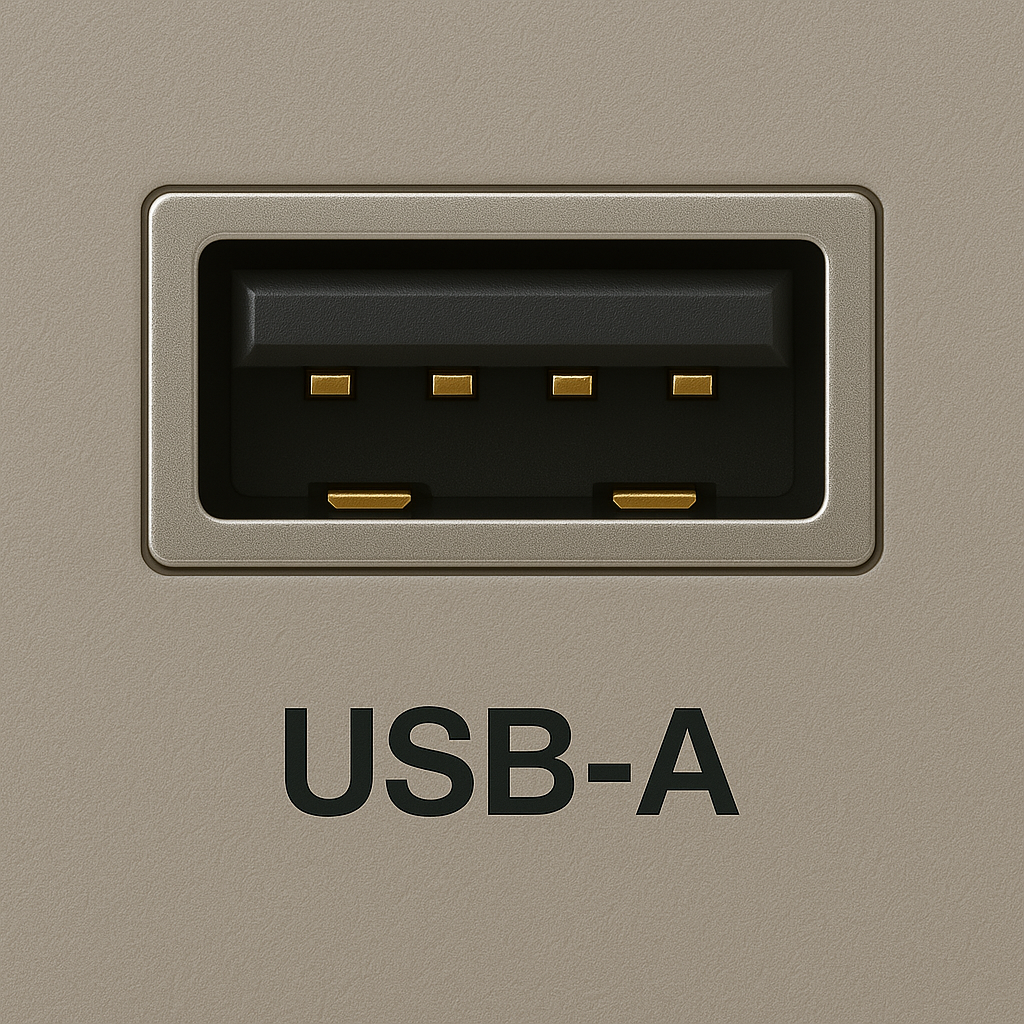
| Name | USB port |
| Maximum speed?Speed The speed here is the theoretical speed, not actual speeds that are achieved regularly. | 12Mbps (version 1.1), 480Mbps (version 2.0) |
| Colour?ColourThis is the colour as defined by PC 98 standard. It was not always enforced, but manufacturers generally followed it. |
USB 1
USB 2.0
USB 3.0
USB 3.1 Gen 2
USB 3.x Charging
|
| Pin count | 4 and 9 (USB 3.0) |
| Year | 1996 onwards |
USB, or Universal Serial Bus, the norm nowadays, was designed in 1996, although it did not get much market share until about 1997. Since then, a 2008 report discovered that "over 6 billion products are in the market, and over 2 billion ship a year". These are crazy numbers considering that back in 1996, just twelve years before, USB did not have a single device on the market.
USB quickly became an essential standard across all connectivity. It simply killed off many of the connectors that had been used for years before, replacing them all with a single serial connector. USB replaced RS232 for mice, keyboards, modems and control signals, the LPT parallel port for printers, scanners and webcams, PS/2 for mice and keyboards as well as webcams and finally, the game port for gamepads and joysticks.
In general, USB could be seen as the connector for anything and everything, thus a universal solution.
The widespread use of USB also pushed the adoption of serial connectivity over parallel connectivity and more universal serial connectivity standards such as Firewire.
DVI (Digital Visual Interface)
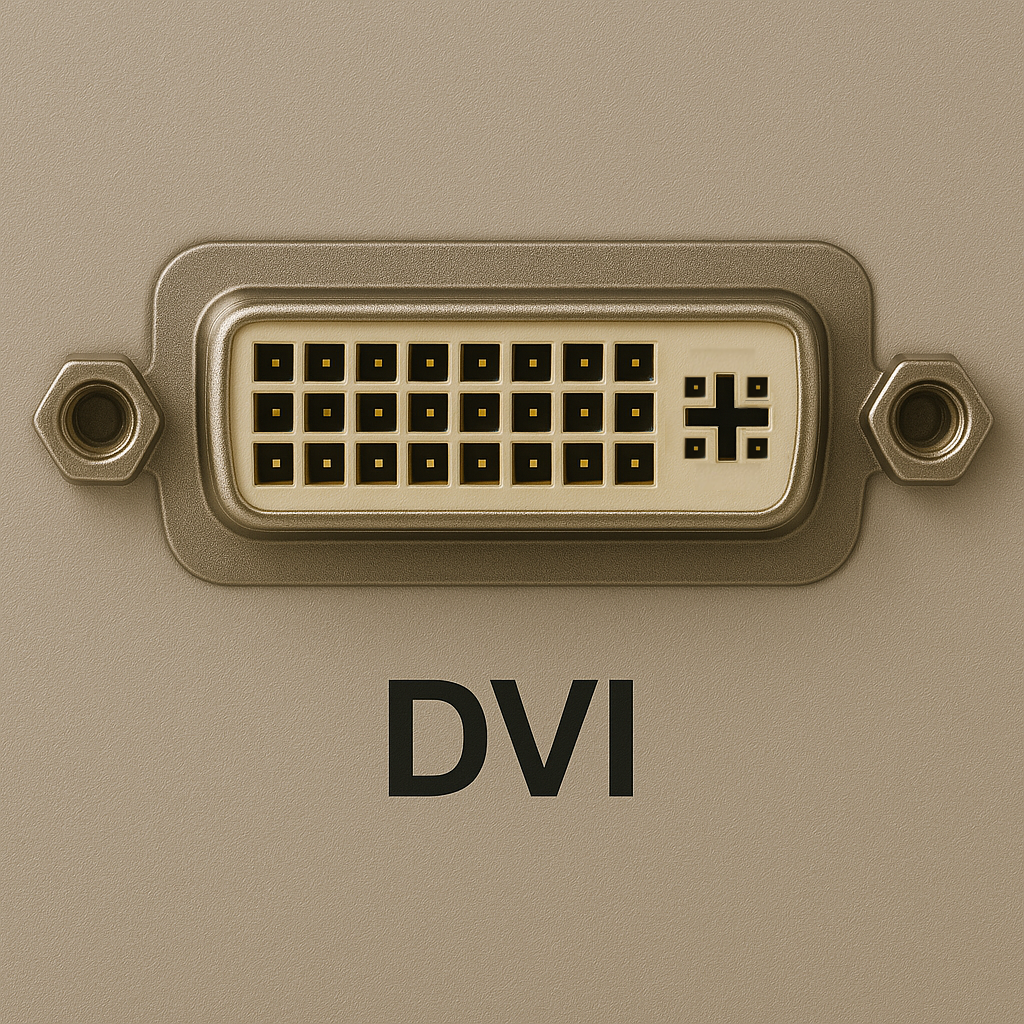
| Name | DVI (Digital Visual Interface) |
| Maximum speed?Speed Dual-link DVI supports resolutions up to 2560×1600 at 60Hz. Single-link DVI supports up to 1920×1200. | 9.9 Gbps (dual-link) |
| Colour | |
| Pin count | 29 (DVI-I dual-link) |
| Year | 1999 – early 2010s |
DVI, or Digital Visual Interface, is a video display interface developed to transmit uncompressed digital video. It comes in several formats, including DVI-D (digital only), DVI-A (analogue only), and DVI-I (integrated digital and analogue). Each format may be single-link or dual-link, with the latter supporting higher resolutions.
The DVI connector is characterised by a grid of square pins and a distinctive “plus sign” with four surrounding pins on DVI-I and DVI-A, used for analogue signals. DVI was widely used for computer monitors, projectors, and graphics cards before HDMI and DisplayPort became mainstream.
While still supported on some professional and legacy equipment, DVI has largely been replaced by fully digital connectors that support audio, higher resolutions, and smaller form factors.
FireWire 800
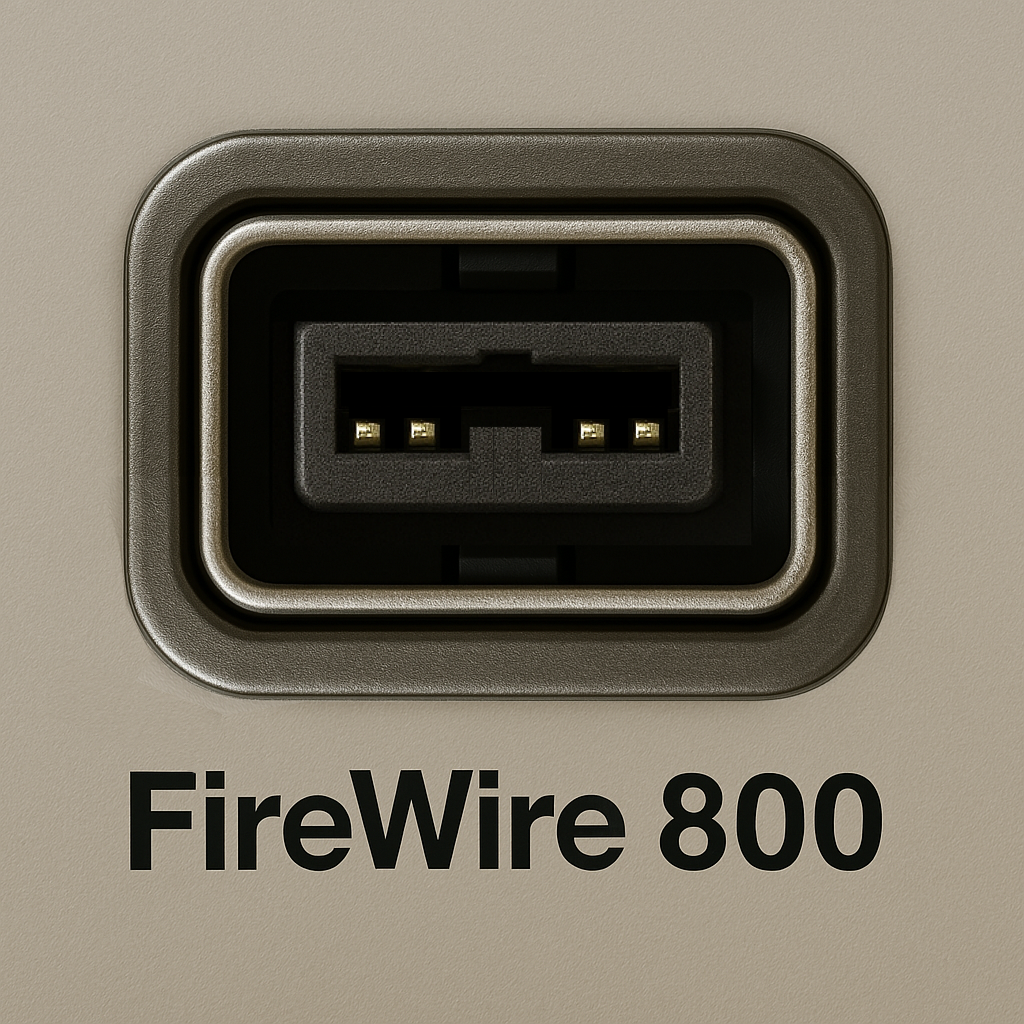
| Name | FireWire 800 (IEEE 1394b) |
| Maximum speed?Speed Maximum theoretical transfer rate supported by the port. | 800Mbps |
| Colour | |
| Pin count | 9 |
| Year | 2003 – 2012 (mainstream use) |
FireWire 800, officially known as IEEE 1394b, was introduced in 2003 and improved on the original FireWire 400 standard by doubling the maximum speed to 800Mbps. It uses an entirely different 9-pin connector that is rectangular in shape with a notch in the middle on the long side.
This port was commonly found on Apple Mac computers and some high-end PCs, as well as external hard drives and audio/video capture devices. It supports daisy-chaining and is capable of full-duplex communication (sending and receiving simultaneously).
Although it offered advantages over USB 2.0 in sustained throughput and CPU usage, FireWire 800 was eventually displaced by USB 3.0 and Thunderbolt. Adapter cables were available to convert FireWire 800 to 400, but direct compatibility required ports that specifically supported both.
HDMI
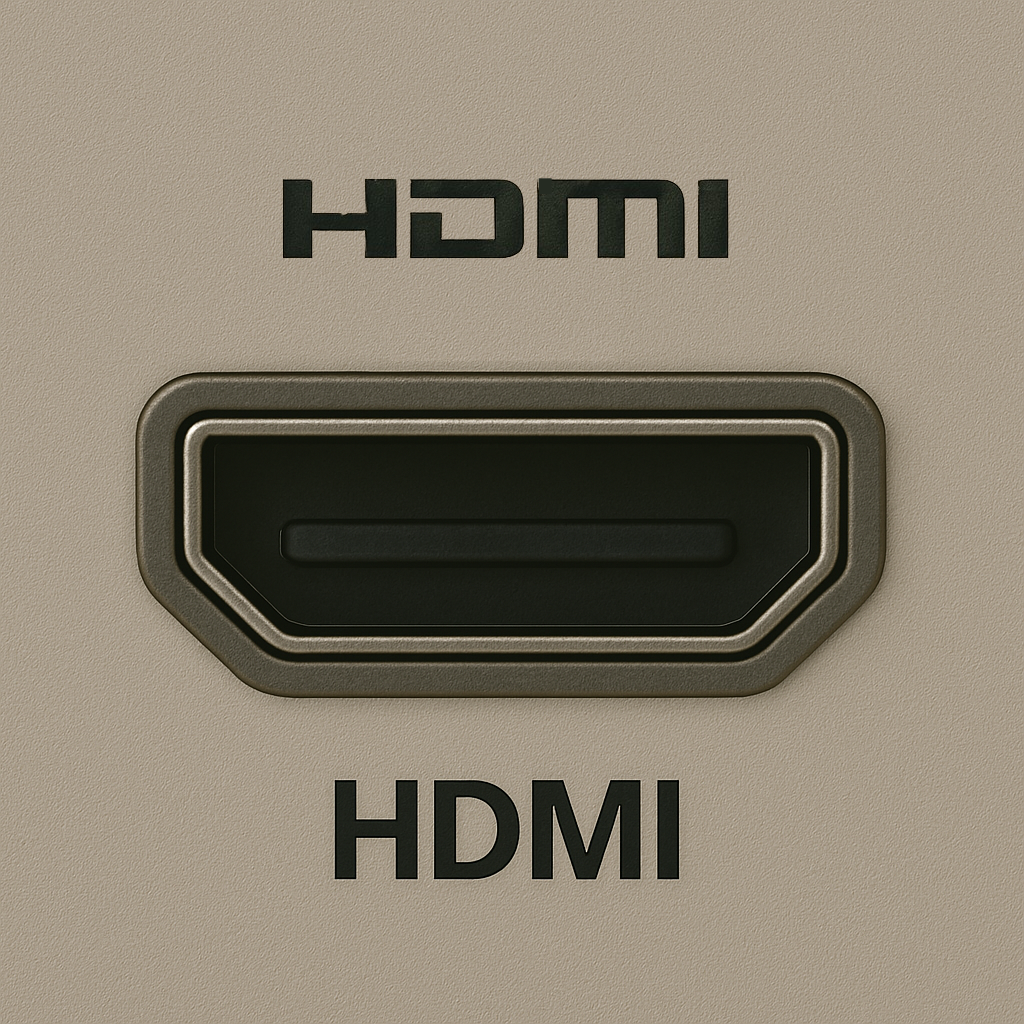
| Name | HDMI (High-Definition Multimedia Interface) |
| Maximum speed?Speed Refers to the maximum theoretical bandwidth supported by the latest HDMI version using this connector. | 48Gbps (HDMI 2.1) |
| Colour | |
| Pin count | 19 |
| Year | 2003 – present |
HDMI (High-Definition Multimedia Interface) is one of the most widely used digital video and audio interfaces in consumer electronics. Introduced in 2003, HDMI supports both video and multi-channel audio through a single cable and is the standard for TVs, projectors, games consoles, and many PCs.
The HDMI Type-A connector is flat and trapezoidal, with a wide bottom and slightly angled top corners. It features 19 pins arranged across a single row inside a black plastic tongue. Unlike USB or Displayport, it does not have a visible female insert - instead, cables have the male connector with the pins exposed.
HDMI supports resolutions up to 8K at high refresh rates, depending on the version. HDMI 2.1 introduced features like Variable Refresh Rate (VRR), Auto Low Latency Mode (ALLM), and enhanced audio return channel (eARC), making it ideal for high-end TVs and gaming.
Thanks to its universal compatibility and content protection (HDCP) support, HDMI continues to be the most common AV connector across devices worldwide.
eSATA
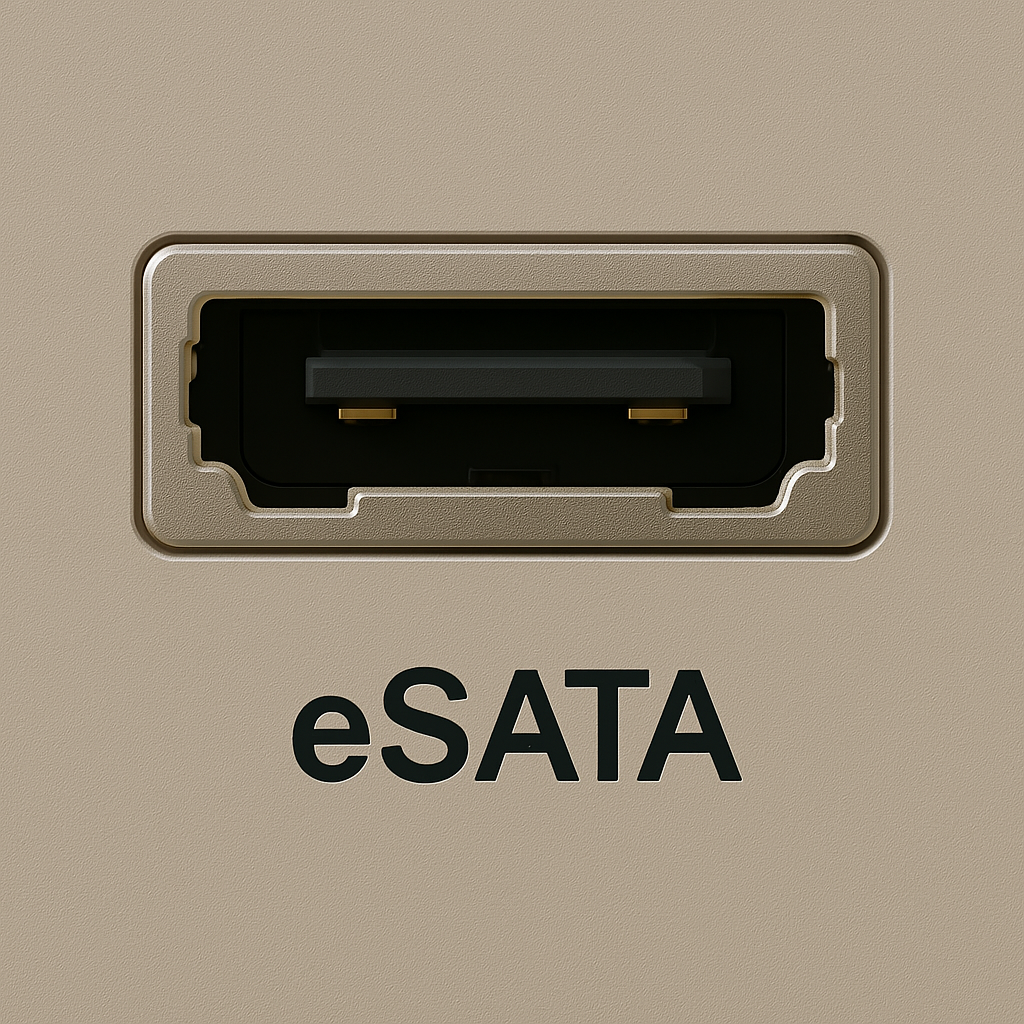
| Name | eSATA (External Serial ATA) |
| Maximum speed?Speed Refers to the maximum supported by the eSATA interface, which corresponds to the SATA version. | 6Gbps (SATA III) |
| Colour | |
| Pin count | 7 |
| Year | 2004 – 2010s (mainstream) |
eSATA, short for External Serial Advanced Technological Attachment, is an interface standard that allows external devices such as hard drives and optical drives to connect using the SATA protocol, but in a more durable and shielded connector suitable for external use.
While eSATA offers the same speed as internal SATA (up to 6Gbps with SATA III), it does not provide power over the cable—unlike USB. This meant external eSATA drives often required a separate power supply, contributing to its eventual decline in favour of USB 3.0 and Thunderbolt. Given the similarities in the ports, there were combo ports, known as the eSATAp port, that acted as an eSATA or a USB port. These ports could also provide power across the port to an eSATA device of up to 5V or 12V.
During the earlier storage interface wars between eSATA, FireWire and USB, eSATA was often the fastest of the three but the least used.
Though largely phased out on consumer hardware, eSATA may still be found on older workstations, docking stations, and storage solutions due to its reliable high-speed data transfer capabilities.
DisplayPort
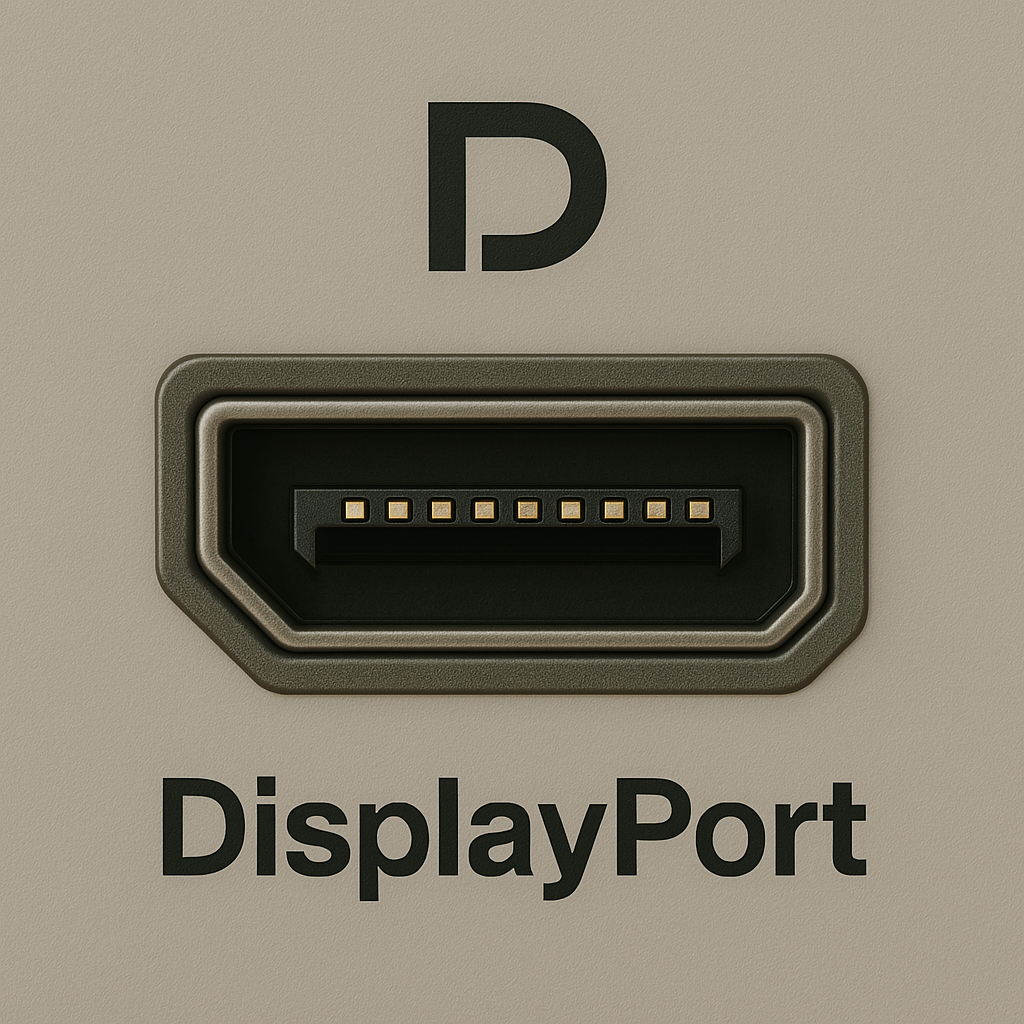
| Name | DisplayPort |
| Maximum speed?Speed Refers to the maximum theoretical throughput supported by the version of DisplayPort. | Up to 77.4Gbps (DisplayPort 2.1) |
| Colour | |
| Pin count | 20 |
| Year | 2006 – present |
DisplayPort is a digital display interface developed by the Video Electronics Standards Association (VESA) to replace older standards like VGA and DVI. Introduced in 2006, it has become a standard for high-resolution monitors, especially in professional and gaming applications.
The DisplayPort connector is asymmetrical, with one notched corner on the lower left and a locking mechanism to prevent accidental disconnection. It transmits audio and video and supports high refresh rates and resolutions, including 8K and beyond with newer versions.
Unlike HDMI, which was initially developed for consumer electronics, DisplayPort is aimed at computers and professional use. It also supports the daisy-chaining of monitors using Multi-Stream Transport (MST).
DisplayPort is still in wide use, especially on desktop graphics cards, docking stations, and high-end monitors, and remains one of the most feature-rich video interfaces available today.
Thunderbolt 1 / 2 (Mini DisplayPort)
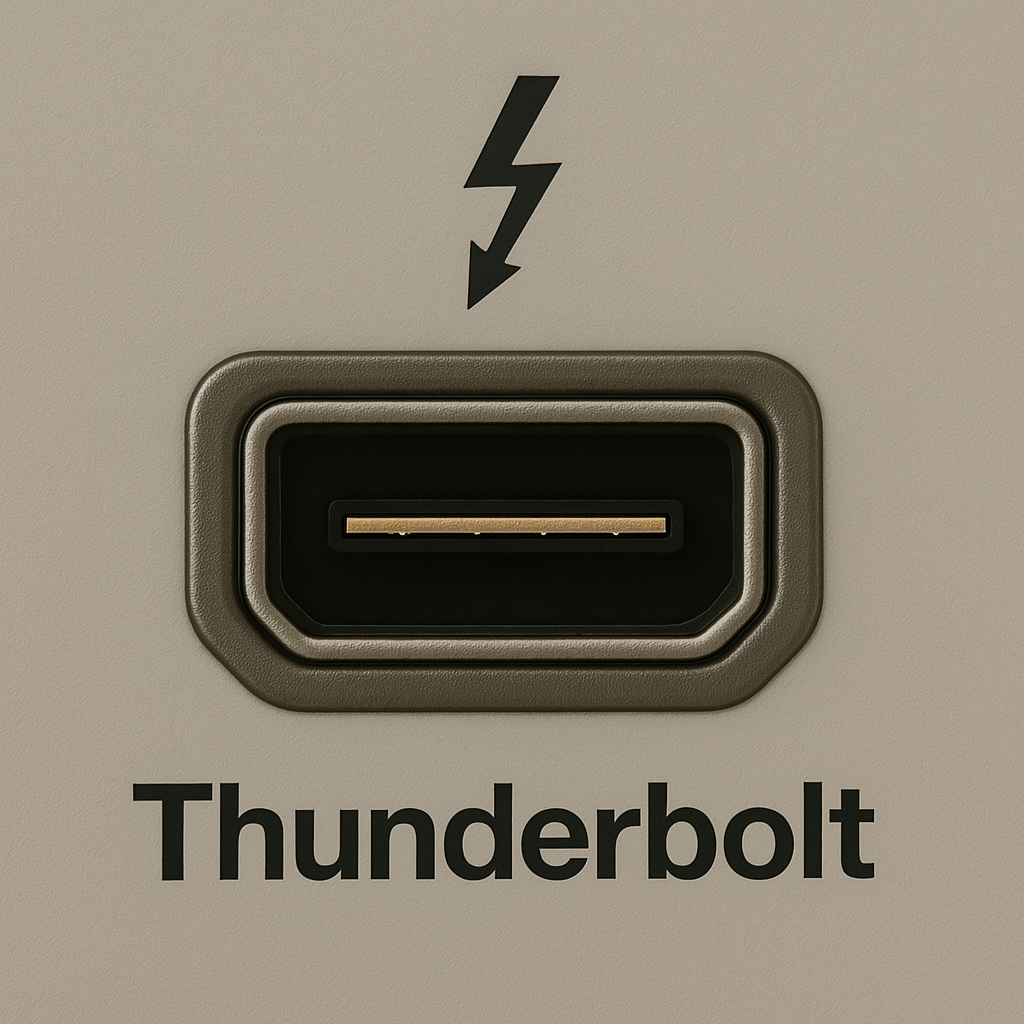
| Name | Thunderbolt 1 / 2 (Mini DisplayPort) |
| Maximum speed?Speed Thunderbolt 1 supports 10Gbps, Thunderbolt 2 supports 20Gbps over the same connector. | 10Gbps (Thunderbolt 1), 20Gbps (Thunderbolt 2) |
| Colour | |
| Pin count | 20 |
| Year | 2011 – 2016 (mainstream use) |
Thunderbolt 1 and 2 used the same connector as Mini DisplayPort but included additional data lines for extremely fast data transfer and device chaining. Thunderbolt 1 supported up to 10Gbps, while Thunderbolt 2 doubled that to 20Gbps using channel bonding.
The port looks identical to Mini DisplayPort but is usually marked with a lightning bolt symbol above the connector. It supports both DisplayPort video and PCI Express data over a single cable, enabling fast external storage, docking stations, and even external GPU support in some cases.
Thunderbolt 1 and 2 were widely used on Apple computers and high-end PCs but have since been replaced by Thunderbolt 3 and 4, which use the USB-C connector. Despite their similar appearance, Thunderbolt 1/2 ports are incompatible with Mini DisplayPort peripherals that rely on data (only video).
USB-C
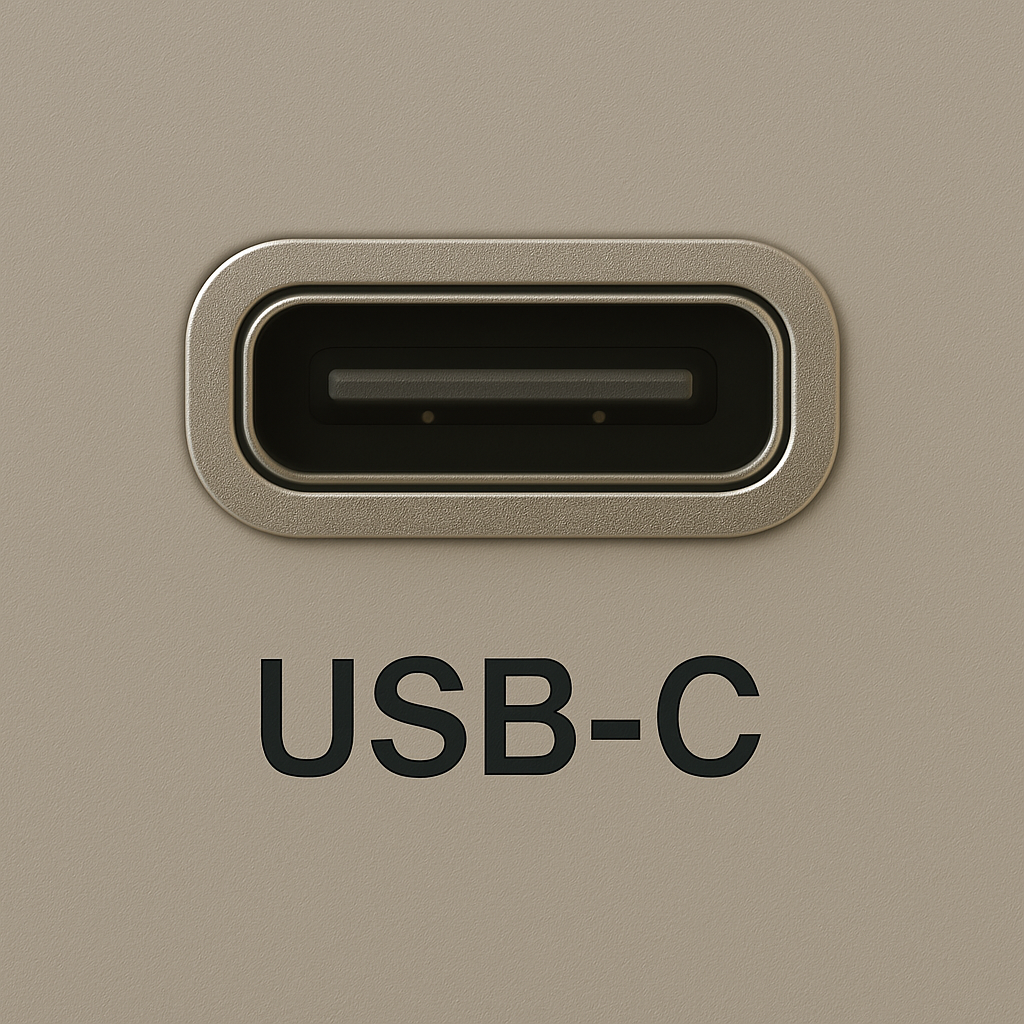
| Name | USB-C (Universal Serial Bus Type-C) |
| Maximum speed?Speed Refers to the maximum theoretical throughput supported by the latest USB version using this connector. | 80Gbps (USB4 v2) |
| Colour | |
| Pin count | 24 |
| Year | 2014 – present |
USB-C is the modern, all-purpose connector standard introduced in 2014 to replace earlier USB formats. It features a compact, symmetrical oval shape that can be inserted either way up, solving one of the biggest complaints with USB-A.
The USB-C port supports a wide variety of protocols, including USB 2.0, USB 3.2, USB4, and even Thunderbolt 3 and 4, depending on the device. It is capable of high-speed data transfer, video output (DisplayPort/HDMI alt modes), and power delivery up to 240W via USB Power Delivery (USB PD).
Physically, USB-C connectors contain 24 pins and use a flat tongue inside the port. The connector is often found on modern smartphones, tablets, laptops, monitors, and docking stations. Due to its versatility and compact size, it has rapidly become the universal port standard across consumer and professional devices.
Despite its unified design, not all USB-C ports offer the same features—some may only support basic charging or USB 2.0 speeds. Users should look for certification labels (e.g., Thunderbolt or USB4 logos) to confirm a port's full capabilities.
Thunderbolt 3, 4 and 5
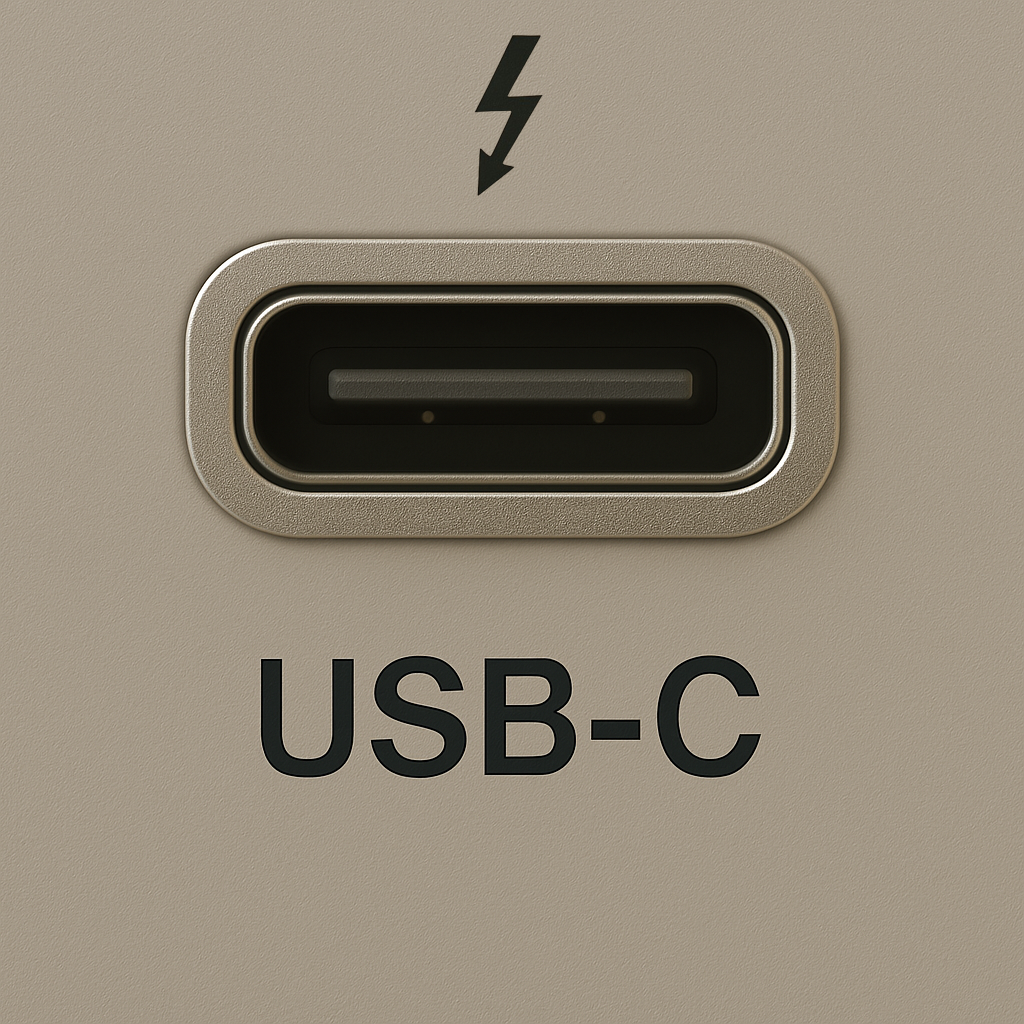
| Name | Thunderbolt 3 Thunderbolt 4 Thunderbolt 5 |
| Maximum speed?Speed Refers to the maximum theoretical bandwidth supported by the version. | Thunderbolt 3 - 40Gbps Thunderbolt 4 - 40Gbps (4) Thunderbolt 5 -80Gbps (up to 120Gbps with Bandwidth Boost) |
| Colour | |
| Pin count | 24 |
| Year | Thunderbolt 3 - 2015 Thunderbolt 4 - 2020 Thunderbolt 5 - 2023 |
Thunderbolt is a high-speed interface standard developed by Intel, using the USB-C connector since version 3. It combines PCI Express, DisplayPort, and USB protocols into one reversible port capable of simultaneously handling data, video, and power.
Thunderbolt 3 introduced the USB-C form factor and supports up to 40Gbps bandwidth, dual 4K displays, and 100W of power delivery. However, support for specific features was optional and varied between devices.
Thunderbolt 4 kept the same 40Gbps speed but standardised the feature set — requiring support for dual 4K displays, PCIe 32Gbps, USB4, and charging. It also added mandatory DMA protection and ensured cable compatibility across devices. Unlike Thunderbolt 3, all Thunderbolt 4 ports must support full 100W charging. Thunderbolt 4 was common on circa 2020 - 2024 Intel Evo-certified laptops, docks, and professional workstations.
Thunderbolt 5 significantly boosts performance, supporting 80Gbps standard transfer and up to 120Gbps with Bandwidth Boost. It also includes PCIe Gen 4 support, higher refresh rate display options, and stronger external GPU performance. Thunderbolt 5 is ideal for high-end creative, gaming, and multi-display workflows. It also enabled support for 8K displays and 540Hz refresh rates at 1080p.
All Thunderbolt versions are backward-compatible with USB-C and earlier Thunderbolt devices when used with the proper cables and adapters.



